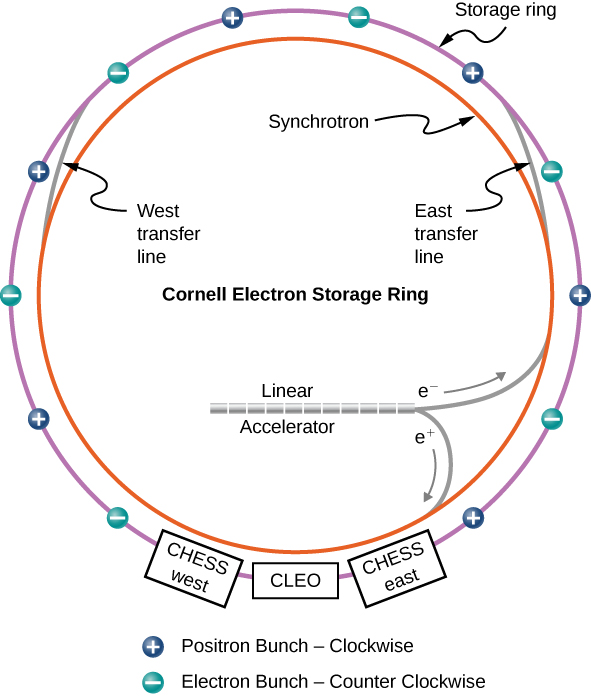| << Chapter < Page | Chapter >> Page > |
Check Your Understanding A charged particle of a certain momentum travels in an arc through a uniform magnetic field. What happens if the magnetic field is doubled?
The radius of the track is cut in half.
New particles can be created by colliding particles at high energies. According to Einstein’s mass-energy relation, the energies of the colliding particles are converted into mass energy of the created particle. The most efficient way to do this is with particle-colliding beam machines. A colliding beam machine creates two counter-rotating beams in a circular accelerator, stores the beams at constant energy, and then at the desired moment, focuses the beams on one another at the center of a sensitive detector.
The prototypical colliding beam machine is the Cornell Electron Storage Ring , located in Ithaca, New York ( [link] ). Electrons ( ) and positrons ( ) are created at the beginning of the linear accelerator and are accelerated up to 150 MeV. The particles are then injected into the inner synchrotron ring, where they are accelerated by RF cavities to 4.5 to 6 GeV. When the beams are up to speed, they are transferred and “stored” in an outer storage ring at the same energy. The two counter-rotating beams travel through the same evacuated pipe, but are kept apart until collisions are desired. The electrons and positrons circle the machine in bunches 390,000 times every second.

When an electron and positron collide, they annihilate each other to produce a photon, which exists for too short a time to be detected. The photon produces either a lepton pair (e.g., an electron and position, muon or antimuon, or tau and antitau) or a quark pair. If quarks are produced, mesons form, such as and These mesons are created nearly at rest since the initial total momentum of the electron-positron system is zero. Note, mesons cannot be created at just any colliding energy but only at “resonant” energies that correspond to the unique masses of the mesons ( [link] ). The mesons created in this way are highly unstable and decay quickly into lighter particles, such as electrons, protons, and photons. The collision “fragments” provide valuable information about particle interactions.
As the field of particle physics advances, colliding beam machines are becoming more powerful. The Large Hadron Collider (LHC) , currently the largest accelerator in the world, collides protons at beam energies exceeding 6 TeV. The center-of-mass energy ( W ) refers to the total energy available to create new particles in a colliding machine, or the total energy of incoming particles in the center-of-mass frame. (The concept of a center-of-mass frame of reference is discussed in Linear Momentum and Collisions .) Therefore, the LHC is able to produce one or more particles with a total mass exceeding 12 TeV. The center-of-mass energy is given by:

Notification Switch
Would you like to follow the 'University physics volume 3' conversation and receive update notifications?